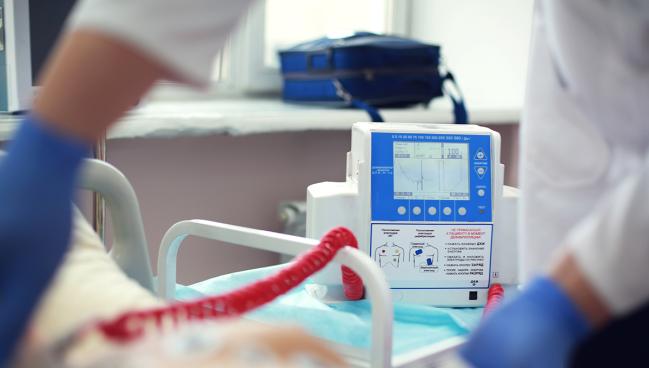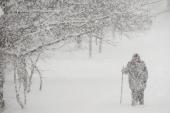Wintertime Brings Increased IHCA Risk, US Data Show
Over a 15-year period, winters saw consistently more in-hospital cardiac arrests than other seasons, though it’s not yet clear why.

In-hospital cardiac arrest (IHCA) occurs more often in winter as opposed to other seasons, according to an analysis that captured 15 years’ worth of US data. The seasonal variation was consistently seen for both men and women, in all regions, and for all age groups above 45 years.
The results were published online recently in JACC: Clinical Electrophysiology.
Variations in out-of-hospital cardiac arrest—circadian, circaseptan (7-day cycle), and seasonal—are well documented, but less is known about shifts in IHCA risk, senior author Arshad Jahangir, MD (Aurora Sinai/Aurora St. Luke’s Medical Centers, Advocate Aurora Health, Milwaukee, WI), told TCTMD.
Although what their study found in IHCA isn’t unexpected, as it’s consistent with seasonal variations seen in other diseases, “what surprised us is the magnitude and the consistency of this over the years. You can see it’s a sawtooth type of curve that we see—it reproduces every year and it has not changed,” he noted.
Muddasir Ashraf, MD (Aurora Sinai/Aurora St. Luke’s Medical Centers, Advocate Aurora Health), lead author of the new study, pointed out that there’s also evidence that survival varies by the season among patients with out-of-hospital cardiac arrest. In their look at IHCA, however, “we did not see the seasonal variability in mortality,” he observed.
What surprised us is the magnitude and the consistency of this over the years. Arshad Jahangir
The researchers, using the National Inpatient Sample, identified nearly 1.5 million patients (mean age 66 years; 44% female) who experienced IHCA between 2005 and 2019.
Across the 15-year period, IHCA more often occurred in winter versus other seasons, even when accounting for potential confounders. In 2019, for example, the adjusted odds ratio for winter versus summer was 1.08 (95% CI 1.005-1.15). The patterns persisted in male and female patients, middle-aged and elderly patients, and the Northeast, South, Midwest, and West.
IHCA with nonshockable rhythm was more common and thus drove the seasonal differences, but winter still was risker even for IHCA with shockable rhythm. For those with shockable rhythm, hospital admission was most often due to STEMI, sepsis, and NSTEMI. For those with nonshockable rhythm, the most frequent reasons were sepsis, acute hypoxic respiratory failure, and heart failure (HF).
Independent predictors of higher IHCA risk included not only winter, but also numerous other factors: white race, comorbidities (eg, peripheral vascular disease and HF), older age, male sex, acute presentation (STEMI, NSTEMI, or ischemic stroke), sepsis, pneumonia, atrial fibrillation, acute renal failure or pulmonary embolism, lack of insurance, low income, hospitals that were urban and had more beds, and hospitals located in the US South and West regions (versus Northeast). Lower risk of IHCA was seen for patients with obesity, tobacco abuse, and private health insurance.
In-hospital mortality after IHCA was similar irrespective of the season, with no rise in winter. The death rate in this study even dropped from 2005 to 2015. “It is encouraging to see that there is a decrease in mortality over time,” Ashraf said, though the curve plateaued thereafter.
What Clinicians Can Do
Why IHCA is more common in wintertime than other times of the year isn’t certain, the investigators say, and there’s still a need to identify who’s most at risk.
Among the patients with nonshockable IHCA, the original reasons for their hospitalization point to opportunities. Sepsis and respiratory failure were the dominant reasons, at 48% and 14%, respectively, and another 5% were hospitalized for pneumonia. “Better vaccination, better . . . care of these patients who have chronic illnesses while they are in hospital” could help prevent the IHCA from happening, said Jahangir.
Especially for elderly patients with comorbidities, said Ashraf, it’s important to be meticulous about deep venous thrombosis prophylaxis, address atrial fibrillation, and take steps to prevent infections like pneumonia and sepsis. “If patients do develop sepsis, they should be treated promptly so we can prevent these catastrophic outcomes,” he specified.
“Additionally, whether staffing issues caused by higher hospitalization rates during the winter months contribute to the worsening medical status of vulnerable patients predisposed to IHCA is another concern that warrants further evaluation,” the paper notes. Thus, better nurse staffing might be a means of smoothing out the seasonal variations.
The reality of climate change is driving more and more research on how extreme temperatures and weather events will—and already have begun to—affect cardiovascular risk. Moving forward, how this issue relates to cardiac arrest needs to be studied, said Jahangir, though he predicted it will be hard to tease out the effects of complex, overlapping factors. In their 15-year dataset, although the seasonal patterns were consistent, the incidence of IHCA rose over time—at least in part, he added, because more elderly patients were surviving with cardiovascular disease and other comorbidities.
Caitlin E. Cox is News Editor of TCTMD and Associate Director, Editorial Content at the Cardiovascular Research Foundation. She produces the…
Read Full BioSources
Ashraf M, Sulaiman S, Alyami B, et al. Seasonal variation in the incidence of in-hospital cardiac arrest. J Am Coll Cardiol EP. 2023;Epub ahead of print.
Disclosures
- Ashraf and Jahangir report no relevant conflicts of interest.





Comments